|

This remarkable flag is
one of the earliest, if not the earliest,
surviving examples of the American Flag. Research on
this flag led to some fascinating insights into the
early history of the American Flag that is often
completely overlooked, or only minimally discussed, in
most books and accounts written about the topic. The period
between the first Flag Act of 1777, which established
the thirteen stars and thirteen stripes pattern for the
American Flag, and the second Flag Act of 1794, which
adjusted the flag to fifteen stars and fifteen stripes
following the introduction of Vermont and Kentucky into
the Union, was in fact a period of radical and rapid
change in the governance of the United States of America.
Following the signing of the Declaration of Independence
in July, 1776, the Second Continental Congress set about drafting the "Articles of
Confederation and Perpetual Union" as the governing
document over the national federation of the thirteen
states. On June 14, 1777, while the Articles of Confederation were
still being
drafted, Congress passed the Flag Act of 1777
establishing the thirteen stars and stripes as the flag
of the United States, This first Flag Act was passed
by a wartime Congress presiding over a loosely banded union of
colonial states which had not yet organized under a
federal government charter. It was not until
November 15, 1777, months after the Flag Act of 1777 was already
passed, that Congress approved
the Articles of Confederation, which were not ratified
and in effect until March 1, 1781. While the thirteen original
colonies were united as states in the common cause of
the Revolution and securing their declared
independence from Great Britain, at this early time they still operated
very much as independent states without a democratically
elected national
leader or a strong centralized federal
government.
The Articles of Confederation and Emergence of the
United States Constitution, 1781-1787
Securing victory in the Revolutionary War, which
formally ended with the Treaty of Paris
on September 3, 1783, led to the obvious next step for
the colonies, which was to determine what form the
government of the United States of America would take now that they were
recognized formally as separate and independent of Great Britain. Yet almost
from the beginning, it became clear that the Articles of
Confederation were not sufficiently strong enough to
bind the member states together under an effective
central governance structure. During the war, in 1781, debates about
taxation and raising revenues to begin repaying mounting war
debts proved contentious. Since the Articles of
Confederation did not expressly give Congress the right
to raise taxes, unanimous consent of the member states
was required to do so. Rhode Island refused to consent
to giving Congress the power of taxation, highlighting
the limitations of the Articles of
Confederation as a governance structure to maintain
unity and implement policies supported by a majority,
rather than the totality, of its members. Rhode Island,
in particular, proved to be a challenging partner in the
federation, strongly protective of its state's rights.
This was understandable to a degree, since there did not
exist significant guarantees of citizens' rights, such
as those which would come a decade later with the
passage of the Constitution's Bill of Rights. It is
Rhode Island's intransigence with regards to ceding
powers to a federal government that
is likely directly related to the existence of this
twelve star flag.
By
1786, struggling fiscally under the burden of debt
from the Revolution and unable to pass measures under
the Articles of Confederation to jointly remedy the
burden, leaders of several states
proposed to convene to revise the Articles of
Confederation. The "Meeting of Commissioners to Remedy
defects of the Federal Government" in Annapolis drew
few attendees, but it laid the foundation for a second
meeting in Philadelphia the following year. When the
States finally met in Philadelphia to review the
Articles of Confederation in June, 1787, Rhode Island
did not send delegates, and only twelve states were
represented. The reviewing body, which became the
Constitutional Convention, determined that rather than
attempting to remedy the defects of the Articles of
Confederation, a new governing charter, the United
States Constitution, would be drafted. Rhode Island,
still
wary of federal interference in its practices of
printing its own paper money as well as other perceived
threats to its autonomy and its citizens' religious and
personal freedoms, not only abstained from
attending the
Constitutional Convention, but also did not attend the
signing ceremony, making it the only one of the 13
original states not to be a signatory to the
Constitution.1
Ratification of the United States Constitution, 1787
The United States Constitution required nine states to
ratify it before it came into effect. One by one, the states began holding
ratification conventions to discuss and ratify the
Constitution. The country watched as each state debated
the Constitution and voted to ratify it.
A running
political cartoon in the Massachusetts Centinel
illustrates how the country anticipated each ratifying state
as a new "star" in the new country's constellation.
Flouting the letter and spirit of Article Seven of the
proposed Constitution, the Rhode Island General
Assembly called for a statewide referendum rather than a
state convention, and Rhode Island voters overwhelmingly
rejected the Constitution on March 24, 1788. By the time
of Rhode Island's rejection, six states had already
ratified the Constitution.2
|
Upon ratification of the Constitution by the
ninth state, the United States of America
entered into an unusual status which, from a
flag history perspective, is often overlooked.
The transition of the governance of the United
States from the Articles of Confederation to the
Constitution was not instantaneous. Once the
Constitution was officially adopted on June 21,
1788, it was agreed that on March 4, 1789,
governance under the Articles of Confederation
would officially end and the Constitution would
come into effect.3
Virginia ratified on June 25,
1788, and New York ratified on July 26, 1788.
But two hold-out states--North Carolina and
Rhode Island--had still not ratified the
Constitution by the time it came into effect. Thus, the
first government of the United
States of America under the Constitution of the
United States began with just eleven states.
On March 4, 1789, the 1st United States Congress
convened in New York City and declared the new
Constitution to be in effect. Only the eleven
states that ratified the Constitution had
Representatives and Senators seated in Congress.
“At sunset on the evening of
March 3d [1789], the old Confederation was fired
out by thirteen guns from the fort opposite
Bowling Green in New York; and on Wednesday, the
4th, the new era was ushered in by the firing of
eleven guns in honor of the eleven States that
had adopted the Constitution.4
The States of Rhode Island and North
Carolina, now severed from the American Union,
were as independent of each other as England and
France. "All sea-captains," said a Providence
newspaper5,
"belonging to this State, will sail under the
sole protection of the State of Rhode Island,
having no claim to the flag of the United
States, for the eleven confederate States are,
in fact, the United States."6,
7
George Washington, elected on February 4, 1789
by a slate of electors from ten states (New York
failed to field a slate of electors, and North
Carolina and Rhode Island had not ratified the
Constitution), was inaugurated on April 30,
1789, as President of just eleven states. A
first-hand description from Washington's journey
from Mount Vernon to New York City for the
inauguration, makes an interesting observation
about the flags flying during his travels:
“The
greatest day that Gray's Ferry bridge ever knew
was April 20, 1789. On that day George
Washington crossed it on his way to New York to
become first President of the nation which his
sword had called into being. The "Columbian
Magazine” for May, the following month,
contained a fine copper-plate engraving from a
drawing by Charles Wilson Peale of this bridge
as decorated for the occasion, and the following
description:
The
whole railing, on each side of the bridge, was
dressed with laurels interwoven with cedar. A
triumphal arch 20 feet high, decorated with
laurel and other evergreens, was erected at each
end in a style of neat simplicity; under the
arch of that at the west end hung a crown of
laurel, connected by a line which extended to a
pine tree on the high and rocky bank of the
river where the other extremity was held by a
handsome boy, beautifully robed in white linen;
a wreath of laurel bound his brows, and a girdle
of the same his waist. Eleven colours were
planted on the north side of the bridge, in
allusion to those states which have ratified the
constitution; on the south side were two others,
one emblematical of a new acra, the other
representing Pennsylvania—it was the flag which
captain Bell carried to the East Indies, being
the first ever hoisted there belonging to this
state. At the east end of the bridge a striped
cap of liberty was elevated on a pole about 25
feet in height, from which spread a
banner-device, a rattle-snake, with the motto,
"Don't Tread On Me." A large signal flag was
hoisted in the ferry gardens, to give notice of
the general's approach to those who were posted
on the other side of the Schuylkill. On the top
of the ferry post on the west side, a banner was
displayed—the device a sun with this motto,
“Behold the Rising Empire.” On the opposite
shore flew a banner, alluding to commerce-motto:
“May Commerce Flourish.” The ferry boat and
barge were anchored in the river, and displayed
a variety of colours, particularly a jack
bearing eleven stars. About noon the illustrious
Washington appeared and as he passed under the
first triumphal arch the acclamations of an
immense crowd of spectators rent the air, and
the laurel crown, at that instant, descended on
his venerable head. His excellency was saluted
on the common by a discharge from the artillery
and escorted into Philadelphia by a large body
of troops, together with his excellency the
president of the state, and a numerous concourse
of respectable citizens.”8
|



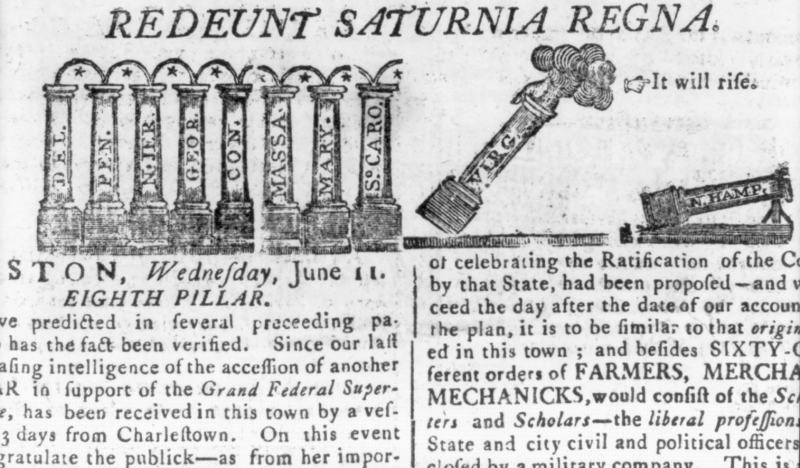
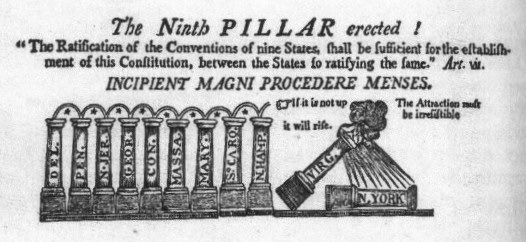
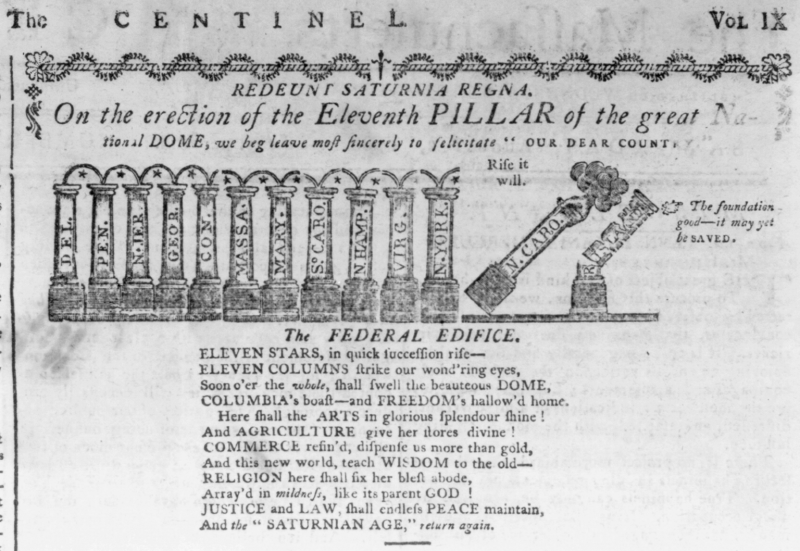
"ELEVEN STARS, in quick
succession rise..."
- August 2, 1788, The Massachusetts Centinel
Source:
Teaching American History |
The
American Flag, between Nine and Twelve Stars, June 21,
1788 to May 29, 1790
Several other 19th and
20th century histories the American
Flag and the events surrounding the tumultuous 1787-1790
period where the Constitution was being ratified,
adopted, and placed into effect, make note of the
unusual circumstances of the number of stars on the
flag. Some repeat the observation of the eleven star
jack present in first hand accounts of Washington's
inauguration journey and others elaborate on other
observed reports of the presence of flags with fewer
than thirteen stars.
“It was, of course, under the Stars and
Stripes that the Constitutional Convention met at
Philadelphia, in 1787, and formulated the fundamental
law of this republic; it was under it that the States
one by one ratified the Constitution and held the first
election of a President and Congress; and it was under
the same banner that in 1789 Washington travelled from
Mount Vernon to New York, and was there inaugurated and
installed as the first President of the United States.
It is said that among the decorations in the city of
Philadelphia as he passed through there was displayed
for the first time the ‘American Union Jack,’ consisting
simply of the canton and its stars, without the stripes,
and that it contained only eleven stars;
North Carolina and Rhode Island not yet having ratified
the Constitution. It appears, moreover, that some other
flags were thus and for the same reason made without the
full number of thirteen stars. Thus some are said to
have been displayed with nine stars
immediately after the ratification of the Constitution
by New Hampshire, the ninth State to do so, at which
time, according to its own provision, the Constitution
was established in full force and effect. A little
later, on July 4, 1788 [sic] there was at Philadelphia a
great celebration of the ratification of the
Constitution, and many flags with ten stars were
displayed, Virginia having also by that time
given her adherence to the instrument. Such adding of
star after star to the Flag as the remaining States
ratified the Constitution may be regarded as
foreshadowing the similar adding of stars as new States
in later years were created and admitted to the Union.”
- The
National Flag, A History, by Willis Fletcher Johnson,
The Riverside Press, Cambridge, Houghton Mifflin
Company, 1930, pp. 68-69.
“When Washington passed through
Philadelphia April 20, 1789 en route to New York to
assume the office of President he was received with
distinguished honors In the river were boats gayly
adorned with ensigns among which was what was then a
novelty an American jack which bore eleven stars
representing the eleven States which had at that time
ratified the Constitution.”
- History
of the flag of the United States of America, by George
Henry Preble, Second Revised Edition, Boston, A.
Williams and Company, 1880, pp. 297-298.
“One banner had been made up in June,
1788, after New Hampshire's ratification (the ninth
state) had ensured the adoption of the new Constitution.
It had but nine stars and nine stripes.”
-
Flags of the U.S.A., by
David Eggenberger, Crowell, 1964, p. 103.
“It would be interesting to know how
large a percentage of intelligent American citizens
remember that at Washington’s inauguration as our first
President, flags bearing only eleven stars
were displayed…”
-The North American Review, Vol. 224,
No. 835, published by the University of Northern Iowa,
Jun-Aug 1927, p. 188.
“The original thirteen States were New
Hampshire, Massachusetts, Connecticut, Rhode Island, New
York, Delaware, New Jersey, Pennsylvania, Maryland,
Virginia, North Carolina, South Carolina and Georgia.
Some of the flags used when only twelve of the States
had ratified the articles of the Convention bore
only twelve stars.”
-
Declaration of Rights of
American Colonies, 1765 and 1774, Declaration of
Independence, Articles of Confederation, Constitution of
the United States and Constitution of the State of
California, published by University of California,
Berkeley, Superintendent State Printing, 1909, p.14
Eleven, Twelve and Finally, Thirteen
The United States of
America, under the Constitution of the United States,
thus operated as a country for a period of nearly 9
months (262 days, from March 4, 1789 to November 21,
1789) with a union of eleven states until North Carolina
ratified the Constitution. It operated as a country for a period of more than 6 months (188 days, November
22, 1789 to May 29, 1790), with a union of twelve states
until Rhode Island ratified the Constitution, finally
bringing the Union to thirteen states and thirteen
stars.
The situation of the
country during these times was very publicly debated and
discussed, and it was only after significant pressure
was applied to Rhode Island, in the form of threatening
to regulate trade with it as though it were a foreign
country, that Rhode Island finally consented to holding
a two ratification convention sessions in March, 1790
and May, 1790, resulting in ratification on May 29,
1790. The question then, is, if a flag maker were asked
to make a Stars and Stripes flag between November 22,
1789 and May 29, 1790, how many stars would they likely
put on the flag? Given Rhode Island's very public and
adamant rejection of the Constitution, even declining to
participate in the process of debating,
drafting, or ratifying it, and declining any governance
union with the newly formed United States of America, it
is very plausible that the flag would have twelve
stars to represent the current union at the time. It is
reasonable too that the flag maker would choose, and be
equally correct with, either twelve stripes or thirteen
stripes. Maintaining the thirteen stripes would preserve
the symbolism from the earliest Continental Colors
and Flag Act of 1777 design of our flag, representing the thirteen original
colonies and states of the Revolution. Even before the Second Flag Act
of 1794 came into effect, which fixed the number of stars at fifteen and the
number of stripes as fifteen following Vermont and
Kentucky statehood, the practice of including
the number of stars to represent the actual number of
states in the Union, thus making the design of the flag
inclusive, was debated vigorously. Regardless of the
debate, the prevalent practice was to add stars with the
addition of states. With the Third Flag
Act of 1818 the official number of stripes reverted to the symbolism of the original
thirteen states of the Revolutionary period, but to this
day, the number of stars on the flag represents, as it
always has, the
number of states in the Union.
This
Twelve Star Flag
All of the physical
characteristics of the twelve star flag at hand show
it being constructed of fabrics made prior to
the widespread adoption of mechanical looms in England
during the Industrial Revolution at the end of the 18th
century. The wool fabrics of
this flag are made of hand spun yarns and hand loomed
wool bunting. It is a coarse, irregular weave that is only seen on a small
handful of the very earliest flags known which typically
date to the War of 1812 or earlier. In particular, this
flag shares many traits of construction and materials
with a rare 13 Star American Flag that dates to the
1790s and flew over the Old Sandy Point Lighthouse in
New York. That flag surfaced at auction in 2007 and was
examined by flag scholars at the time and confirmed to
be an early Federal Period flag. Its construction and
materials were all consistent with circa 1790s flag
making. The flag is now in the Zaricor Flag Collection,
ZFC2497. Comparisons between IAS-00463 and ZFC2497
show strikingly similar materials and construction
techniques, as seen in the photos below.
|
12 Star, 13
Stripe American Flag
circa 1789-1790 (IAS-00463)
|
13 Star, 13
Stripe American Flag, Old Sandy Point Lighthouse, circa 1789-1795 (ZFC2497)
|
|
 |
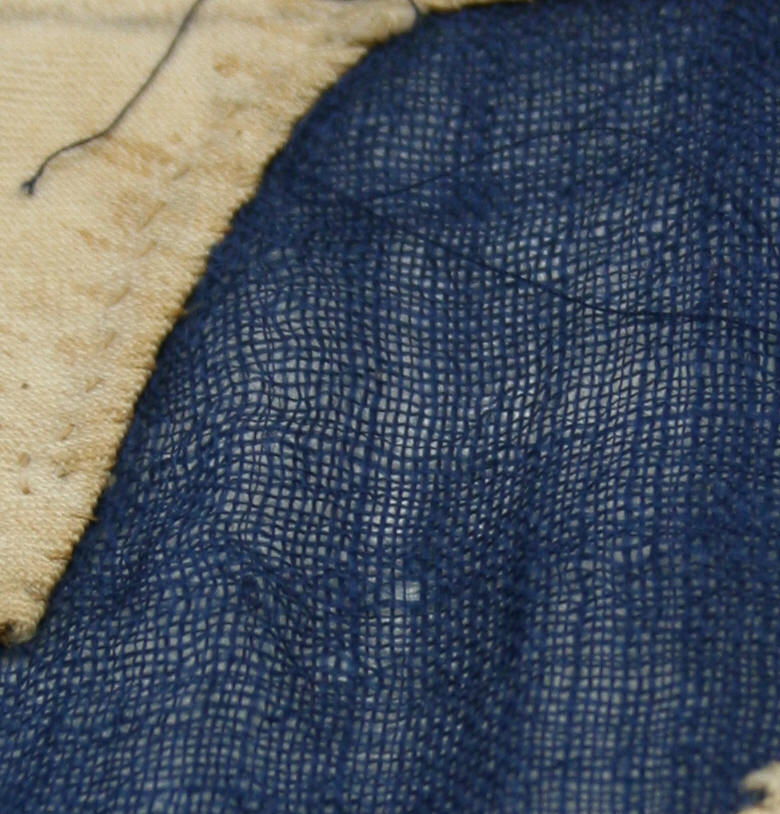 |
|
|
|
 |
 |
|
|
|
 |
 |
|
|
|
 |
 |
|
|
|
Yet another
interesting aspect of the twelve star flag is
the fact that the maker left
space to the left of the central row of stars
for the addition of another star to bring the
total to thirteen. This would make complete
sense if the flag was made between November,
1789 and May, 1790, with the expectation that
eventually Rhode Island (or another state) would
become the thirteenth state. The pattern is clearly an
approximation, minus the one star, of the
prevalent 4-5-4 pattern of thirteen star flags
which was most seen in depictions of thirteen
star flags from
the early days of the Republic. A modified image
of the flag shown at the right shows the flag
with the full complement of 13 stars. Given the
size of the stars on the flag, and the space
available, the flag maker could have fit another
star but chose not to, making it more likely
that the omission was intentional, rather than
accidental. |
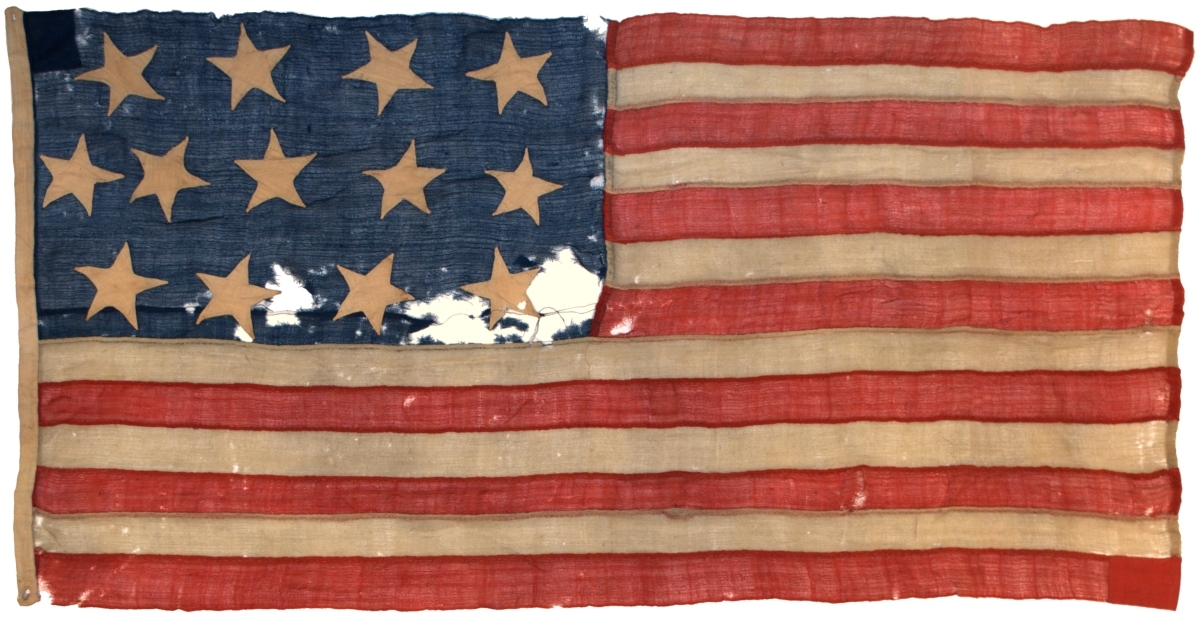
A modified
image of the flag with the 13th star added.
(Note: The top-right star was taken and
mirrored, verifying that the space is sufficient
for stars of the same size as the current ones
on the flag). |
The linen of the
stars is of fine quality for American
manufacture in the 18th century. The linen
threads are home spun and the plain weave of the
linen is approximately fifty threads per inch,
which is the range of the highest quality linens
produced in the colonies and original states in
the 18th century. Coarse linens in the range of
sixteen threads per inch, mid-range linens of
twenty-seven threads per inch, and higher
quality linens of fifty threads per inch were
all grades of linen woven in the American States
in the 18th century. Linen of up to ninety
threads per inch, the finest quality 18th
century linen fabric for sheeting or shirting
materials, was imported from Ireland.9
|
 |

Note the irregular sized
hand spun yarns and hand woven linen
fabric of the stars. |
|

The gauge of the linen
star weave is about fifty threads per
inch, the finest quality
woven in 18th Century America.
|
|

The stars are a fine
linen weave, while the hoist is a coarse
linen weave. Note the similar sheen and
coloration of the fabric.
It is possible the linen is from the
same weaver, just two different gauges.
(Photo taken with flash)
|
All indications
from the flag's construction and materials, as
well as its star pattern and number of stars, is
that the flag dates to the very first thirteen
months of the United States of America as a
nation under the Constitution. The flag would
have been correct, for the number of stars
corresponding to the number of states under the
Federal Government, during the first term of
George Washington's presidency, following the
ratification of the Constitution by North
Carolina but before the ratification of the
Constitution by Rhode Island.
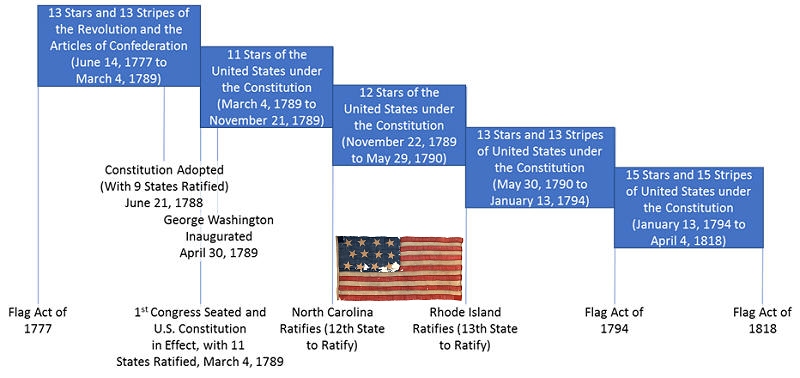
1
Rhode Island State Government Website,
U.S.
Constitution Timeline
2
Wikipedia Timeline of the Drafting and Ratification of
the United States Constitution
3
https://www.history.com/this-day-in-history/u-s-constitution-ratified
4
Massachusetts Centinel, March 14; also Maryland Journal
and Baltimore Advertiser, March 13, 1789.
5
The United States Chronicle, March 3, 1789.
6
"At the first convention in North Carolina the
Constitution was not ratified; but at a second
convention held in November, 1789, it was adopted by a
majority more than two to one, the vote being one
hundred and ninety-three in the affirmative and
seventy-five in the negative. [The official journal
gives the vote 194 to 77.] The Legislature of Rhode
Island, during the session in September, had sent an
address to 'The President, the Senate, and the House of
Representatives of the Eleven United States of America
in Congress assembled,' in which were contained
explanations of the course pursued by the State in not
adopting the Constitution." – (Sparks's Washington, vol.
x., p. 67.)
7
History of the Centennial celebration of the
inauguration of George Washington as first President of
the United States, by Clarence Brown Winthrop, published
by D. Appleton, New York, 1892, p. 4.
8
The Historic Bridges of Philadelphia, An Address
Delivered Before the City History Society of
Philadelphia on Wednesday, October 12th, 1910, Frederick
Perry Powers, published by The Society, January 1914,
pp. 285-286.
9
The Material World of Cloth: Production and Use in
Eighteenth-Century Rural Pennsylvania, by Adrienne D.
Hood, The William and Mary Quarterly, Material Culture
in Early America, Vol. 53, No. 1, Jan., 1996, published
by the Omohundro Institute of Early American History and
Culture, p. 56.
|

